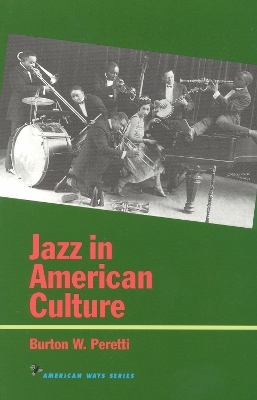
Jazz in American Culture
Ivan R Dee, Inc (Verlag)
978-1-56663-143-3 (ISBN)
This history of jazz, spanning the twentieth century, is the first to place it within the broad context of American culture. Burton Peretti argues persuasively that this distinctive American music has been a key thread in the tapestry of the nation’s culture. The music itself, its players and its audience, and the critical debates it has prompted, tell us much about changes in American life since 1910. Mr. Peretti traces the emergence of jazz out of ragtime during a time of tumultuous growth of cites and industries. In the 1920s jazz flourished and symbolized the cultural struggle between modernists and traditionalists. As American sought reassurance and self-esteem during the Great Depression, jazz reached new levels of sophistication in the Swing Era. World War II encouraged rapid changes in popular tastes, and in the postwar decades jazz became both a voice of a globally dominant America and an avant-garde music reflecting social and political turmoil. Today, Mr. Peretti concludes, jazz symbolizes important cultural trends and enjoys a new prestige in a complex musical scene. Jazz in American Culture tells a peculiarly American story, evaluating the music as well as those who created it, and opening new perspectives on our cultural history.
Burton W. Peretti teaches the humanities at Pellissippi State College. His articles on the cultural aspects of jazz have appeared in a wide variety of magazines, and he has also written The Creation of Jazz.
Part 1 Introduction Part 2 FROM RAGTIME TO JAZZ IN THE 1910s 10 Chapter 3 A modernizing society. Ragtime. Black musicians and the city. James Reese Europe and nightlife. New Orleans. World War I. Part 4 HOT AND SWEET, WHITE AND BLACK: THE JAZZ AGE 31 Chapter 5 The first jazz vogue of the 1920s. Post-Victorian mass leisure. Debate between modernists and traditionalists. African-American communities and jazz. Musicians and the color line. Part 6 THE GREAT DEPRESSION, THE "COMMON MAN," AND THE SWING ERA 61 Chapter 7 Growth of the music and the business. Economic impact of the depression. Political reform and the culture of the thirties. The swing boom in New Deal context. Part 8 JAZZ GOES TO WAR 85 Chapter 9 Economic upheavals after 1939 in society and popular music. Music on the home front and overseas. Evolution of musical tastes. Dixieland and bebop. Critics, musicians, and the postwar temper. Part 10 COOL JAZZ, HARD BOP, AFFLUENCE, AND ANXIETY 109 Chapter 11 Avant-garde music for the atomic age. Jazz and the cold war. Musicians and deviance. California cool. Accelerating change in the late fifties. Part 12 "WE INSIST": JAZZ INSIDE AND OUTSIDE THE 1960s 134 Chapter 13 Jazz and the civil rights movement. The avant-garde and Black Power. The rock revolution and the apparent decline of jazz. Part 14 FUSION AND FRAGMENTATION: JAZZ AT THE END OF THE AMERICAN CENTURY 155 Chapter 15 Fusion and funk in the early seventies. Jazz, country, and the politics of culture. Conservatism and "classic" jazz in the eighties. Race, class, and jazz into the 1990s. Part 16 Epilogue 177 Part 17 Suggested Reading 185 Part 18 Index 191
| Erscheint lt. Verlag | 1.4.1998 |
|---|---|
| Reihe/Serie | American Ways |
| Verlagsort | Chicago |
| Sprache | englisch |
| Maße | 136 x 210 mm |
| Gewicht | 263 g |
| Themenwelt | Kunst / Musik / Theater ► Musik ► Jazz / Blues |
| Sozialwissenschaften | |
| ISBN-10 | 1-56663-143-2 / 1566631432 |
| ISBN-13 | 978-1-56663-143-3 / 9781566631433 |
| Zustand | Neuware |
| Haben Sie eine Frage zum Produkt? |
aus dem Bereich


